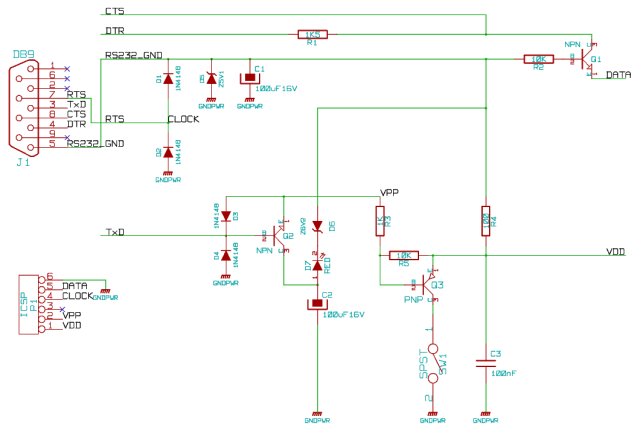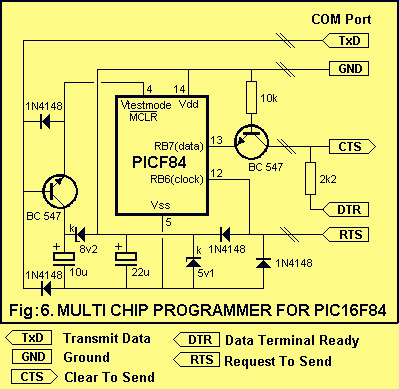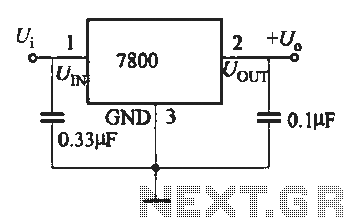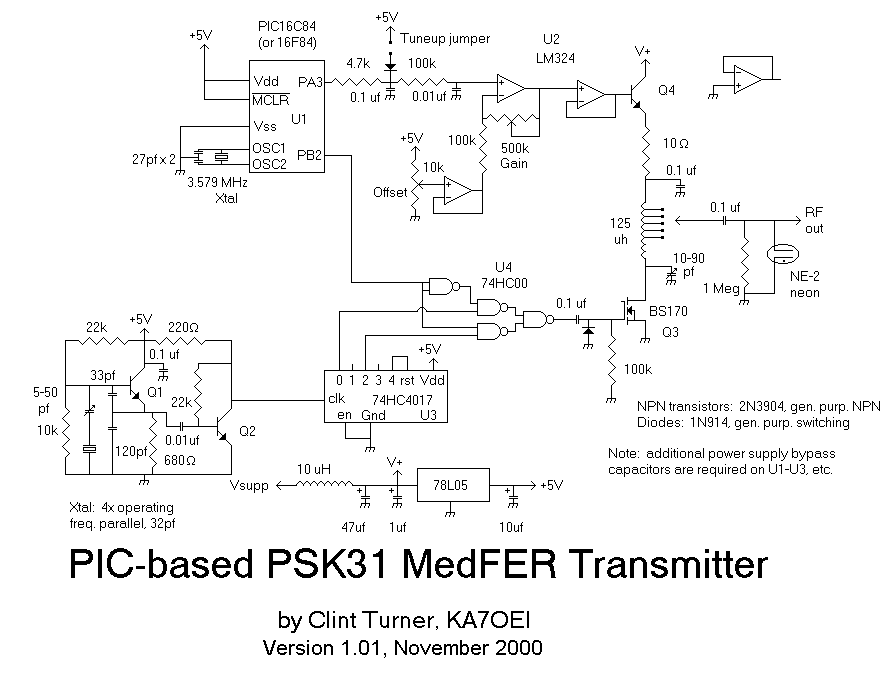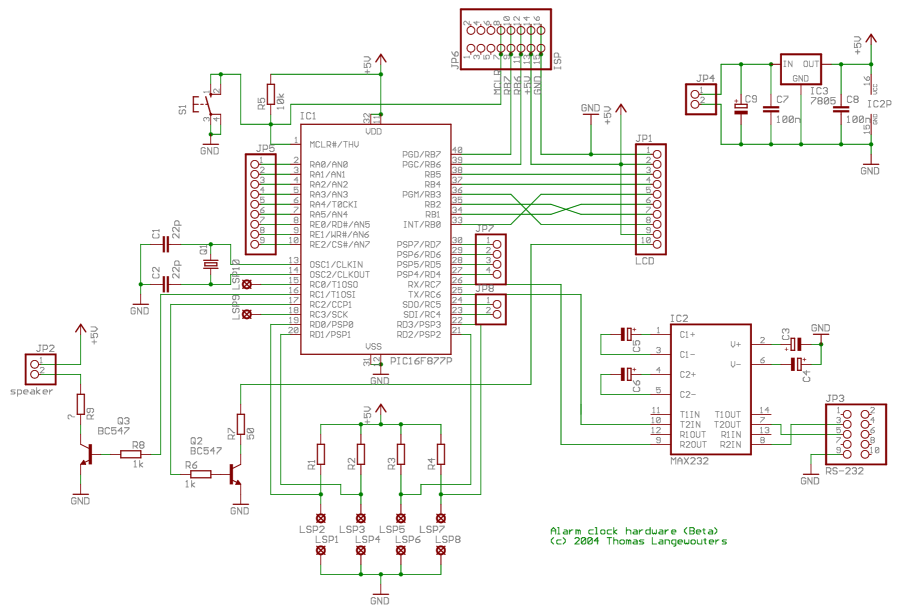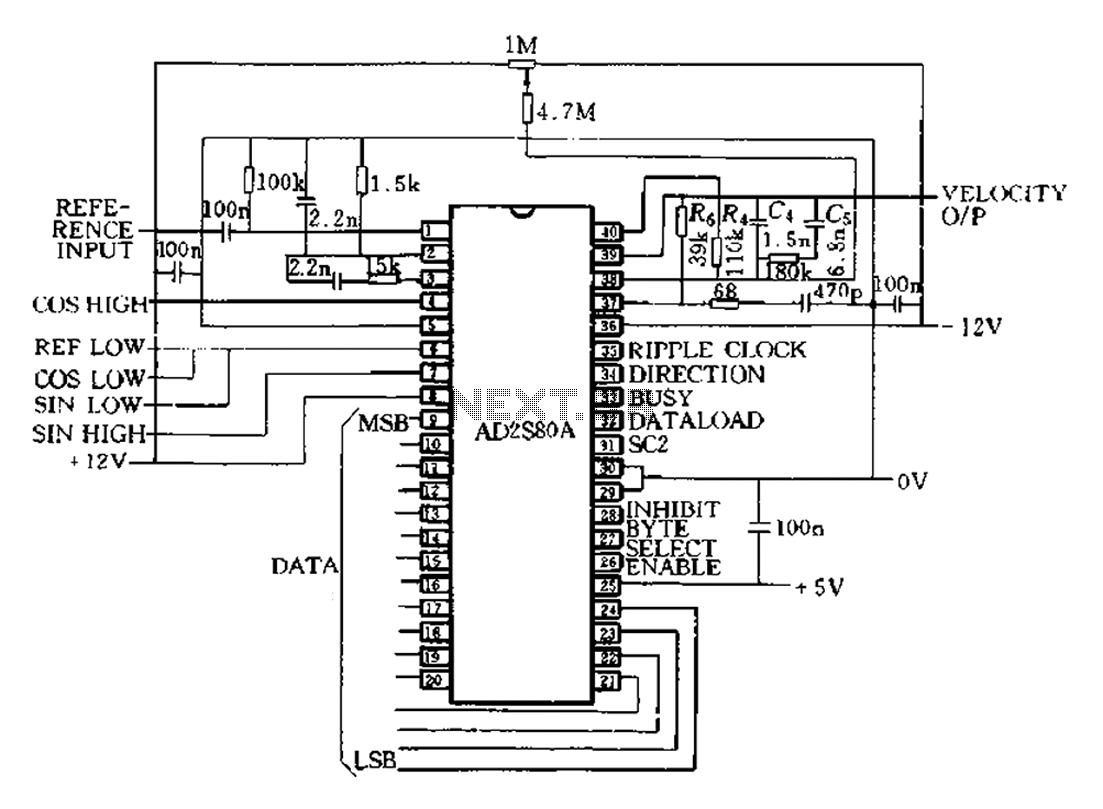
jdm pic programmer

This circuit is simple to build and utilizes ICProg or Vellemann's K8076 picprog 2009 as the programming software. A serial device driver is required for NT4, Windows 2000, or Windows XP, while compatibility with Vista or Windows 7 is uncertain. It is also compatible with Windows 98. Any Linux software compatible with JDM will function as well. The circuit serves as an in-circuit programmer and can also be adapted for use with "bare chips." In addition to the 16F series PIC microcontrollers, it can interface with ISO smart cards and I2C devices, such as 8-pin flash memory, using an appropriate connector. To utilize ICProg, the JDM setting must be selected. The circuit can be assembled in a 25-way plug shell on Veroboard. The ICL7660 component generates a -5V supply from the target +5V, enhancing the output swing for data read from the PIC to the PC for verification. This data is transmitted to the PC through Q3 (2N3906 PNP) and Q5 (2N2904 NPN). The charge pump clock of the ICL7660 drives the voltage multipliers D8 and D11. The output voltage is approximately +5V multiplied by 3, yielding 15V, minus around 4 x 0.65V, resulting in 12.4V. The 12V programming voltage is controlled by Q2 (2N3906 PNP), which is activated by the PC TXD "break" signal via Q1 (2N3904 NPN). Diode D2 pulls the LVM/PGM pin low if it has not been disabled. Diode D6 provides an approximate 4.6V supply rail, ensuring that the protection diodes on the PGD and PGC lines clamp the +12V through series resistors from RS232 to 5V instead of 5.6V, which could lead to latch-up conditions. A red LED indicates that the target board has a +5V supply. It is crucial not to use the programming adapter without a regulated +5V supply on the target or to connect a +5V jack and power supply to the +5V and OV pins of the programming adapter, as this is necessary to power the entire target board. Resistor R1 and diode D7 convert the input data level for the PIC programming data from RS232, while resistor R4 and diode D5 convert the RS232 level for the PIC programming clock. It is important to note that the programmer must receive a +5V supply from the target system. Pin connections for DH Microsystems' prototype board are also included.
The circuit design provides a versatile platform for programming various PIC microcontrollers and other compatible devices. The use of the ICL7660 charge pump enables the generation of negative voltage, which is essential for ensuring proper data transmission and programming functionality. The careful selection of components, such as the 2N3906 and 2N2904 transistors, facilitates the necessary signal conditioning and voltage regulation required for reliable operation.
The programming adapter's layout should be meticulously planned on the Veroboard to accommodate the 25-way plug shell, ensuring that all connections are secure and that the circuit operates as intended. The indicator LED serves a critical role in providing visual feedback about the power status of the target board, which is vital for troubleshooting and ensuring that the circuit is powered correctly before programming attempts.
In summary, this circuit represents a robust and adaptable solution for in-circuit programming of PIC microcontrollers and related devices, with considerations for voltage levels, signal integrity, and user safety integrated into its design. Proper implementation of the described components and adherence to the power requirements will yield a functional and efficient programming tool.This is simple to build and uses ICProg or Vellemann`s K8076 picprog 2009 as the software. You need to add the serial device Driver for NT4, Win2K or XP. I don`t know about Vista/Win7 compatibility. It will run on Windows98 also. Any Linux software for JDM will work it such as or It`s aThis is simple to build and uses ICProg as the software. You need to add the serial device Driver for NT4, Win2K or XP. I don`t know about Vista/Win7 compatibility. It will run on Windows98 also. It`s an Incircuit programmer, though can be used with a simple adaptor for "bare chips". As well as 16F series PIC it can be used with a suitable connector for ISO smart cards and I2C devices such as 8 pin flash Memory. Select JDM on IC-Prog. It can be fitted in a 25 way plug shell on Veroboard U1 ICL7660 generates -5V from the target +5V to improve the output swing on the data (read from PIC to PC for verify) to PC which is fed by Q3 2N3906 (PNP) and Q5 2N2904 (NPN).
The ICL7660 charge pump clock drives voltage multiplier D8. D11. The output is thus +5V x 3 = 15V, but minus 4 x 0. 65V approx. , equals 12. 4v. The 12V programming voltage is switched by Q2 2N3906 (PNP) driven by PC TXD "break" signal via Q1 2N3904 (NPN). The diode D2 pulls LVM / PGM pin low in case this has not been disabled. D6 creates an approx. 4. 6V supply rail so that the protection diodes on PGD and PGC lines clamp the +12V via series resistors from RS232 at 5V rather than 5.
6V which could cause latchup. The Red LED indicates the Target board has +5V supply. Do not attempt to use Progamming adaptor without a regulated +5V supply on the target, or fitting a +5V jack and PSU connecting to the +5V and OV pins of programming adaptor that can power the entire target board. R1 & D7 converts the input data level for the PIC programming data from RS232, and R4 & D5 convert the RS232 level for the PIC programming clock.
Note that the programmer MUST have +5V supply from the target system. Pin connections for DH Microsystems ` Prototype board 🔗 External reference
The circuit design provides a versatile platform for programming various PIC microcontrollers and other compatible devices. The use of the ICL7660 charge pump enables the generation of negative voltage, which is essential for ensuring proper data transmission and programming functionality. The careful selection of components, such as the 2N3906 and 2N2904 transistors, facilitates the necessary signal conditioning and voltage regulation required for reliable operation.
The programming adapter's layout should be meticulously planned on the Veroboard to accommodate the 25-way plug shell, ensuring that all connections are secure and that the circuit operates as intended. The indicator LED serves a critical role in providing visual feedback about the power status of the target board, which is vital for troubleshooting and ensuring that the circuit is powered correctly before programming attempts.
In summary, this circuit represents a robust and adaptable solution for in-circuit programming of PIC microcontrollers and related devices, with considerations for voltage levels, signal integrity, and user safety integrated into its design. Proper implementation of the described components and adherence to the power requirements will yield a functional and efficient programming tool.This is simple to build and uses ICProg or Vellemann`s K8076 picprog 2009 as the software. You need to add the serial device Driver for NT4, Win2K or XP. I don`t know about Vista/Win7 compatibility. It will run on Windows98 also. Any Linux software for JDM will work it such as or It`s aThis is simple to build and uses ICProg as the software. You need to add the serial device Driver for NT4, Win2K or XP. I don`t know about Vista/Win7 compatibility. It will run on Windows98 also. It`s an Incircuit programmer, though can be used with a simple adaptor for "bare chips". As well as 16F series PIC it can be used with a suitable connector for ISO smart cards and I2C devices such as 8 pin flash Memory. Select JDM on IC-Prog. It can be fitted in a 25 way plug shell on Veroboard U1 ICL7660 generates -5V from the target +5V to improve the output swing on the data (read from PIC to PC for verify) to PC which is fed by Q3 2N3906 (PNP) and Q5 2N2904 (NPN).
The ICL7660 charge pump clock drives voltage multiplier D8. D11. The output is thus +5V x 3 = 15V, but minus 4 x 0. 65V approx. , equals 12. 4v. The 12V programming voltage is switched by Q2 2N3906 (PNP) driven by PC TXD "break" signal via Q1 2N3904 (NPN). The diode D2 pulls LVM / PGM pin low in case this has not been disabled. D6 creates an approx. 4. 6V supply rail so that the protection diodes on PGD and PGC lines clamp the +12V via series resistors from RS232 at 5V rather than 5.
6V which could cause latchup. The Red LED indicates the Target board has +5V supply. Do not attempt to use Progamming adaptor without a regulated +5V supply on the target, or fitting a +5V jack and PSU connecting to the +5V and OV pins of programming adaptor that can power the entire target board. R1 & D7 converts the input data level for the PIC programming data from RS232, and R4 & D5 convert the RS232 level for the PIC programming clock.
Note that the programmer MUST have +5V supply from the target system. Pin connections for DH Microsystems ` Prototype board 🔗 External reference
Warning: include(partials/cookie-banner.php): Failed to open stream: Permission denied in /var/www/html/nextgr/view-circuit.php on line 713
Warning: include(): Failed opening 'partials/cookie-banner.php' for inclusion (include_path='.:/usr/share/php') in /var/www/html/nextgr/view-circuit.php on line 713
